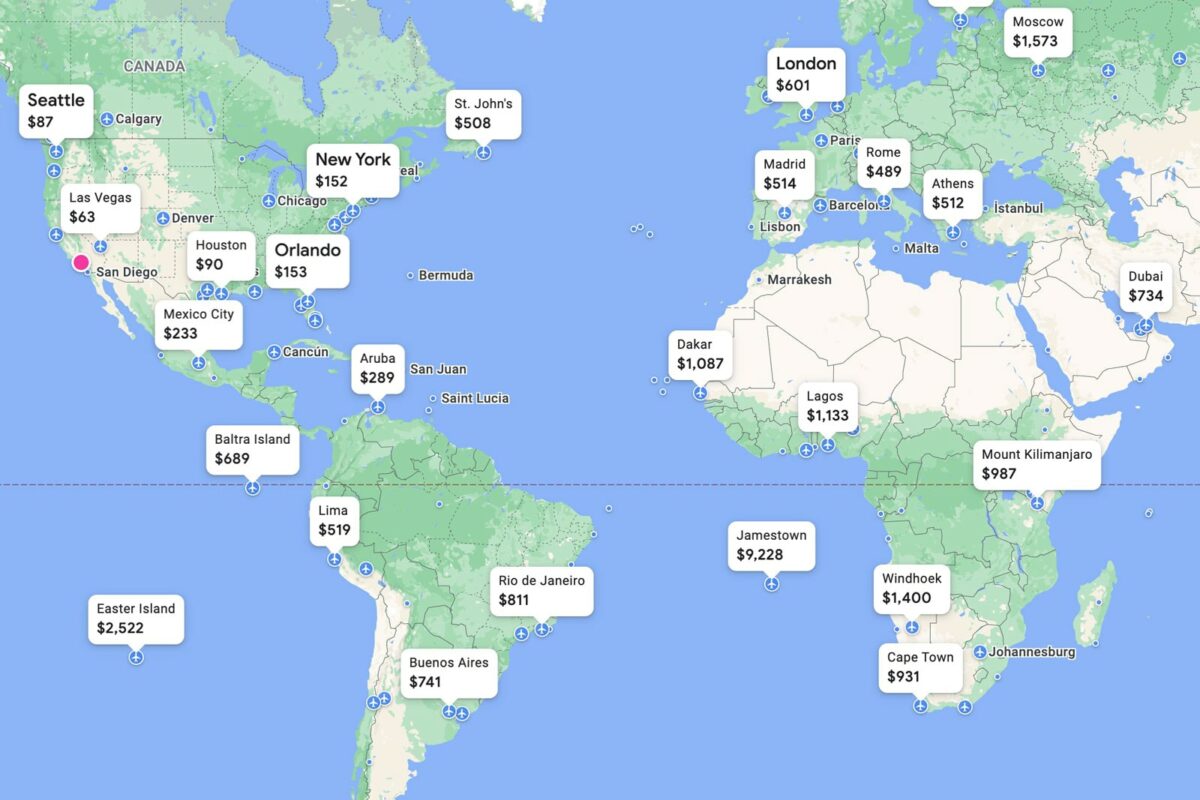Google Flights offers an intuitive and handy platform to find deals and save money on airfare. If you want to utilize the best features of this incredible tool, this is how to use Google Flights.
How to Use Google Flights to Find Cheap Flights
While Google Flights is fairly easy to use, there are some tips and tricks to making the most of the flight search engine and landing the best deals.
This guide will cover the essentials of using Google Flights, including its features, filtering abilities, and pros and cons as a search engine for flight options. This is how to use Google Flights like a pro.
What is Google Flights?
Google Flights is a metasearch engine platform for flights. Google Flights pulls flight prices, schedules, and availability from almost every airline, as well as online travel agencies like Expedia, Kayak, and Orbitz.
In addition to flights, Google Flights can provide search results on hotels, vacation rentals, and things to do in a given destination.
As a search engine tool, Google Flights isn’t used to book flights. Rather, it provides you with flight choices and direct links to the airline or online travel agency to complete the booking based on the search criteria and filters used.
Pros of Google Flights
Many travelers have a preferred method or tried-and-true strategy when it comes to trip planning and finding cheap flights. That being said, Google Flights has some notable advantages that make it adept at snagging you the cheapest fare.
- Highly customizable search filters: Besides flight costs, there are a variety of filter options, such as flight duration and stopovers, to refine your search results and choose the optimal flight.
- Discover the cheapest flights available: By leaving the “Where to?” search bar on the Google Flights page blank and selecting “Flexible Dates”, you can receive a list of the cheapest flights from your selected departure city over the next six months. You can adjust the trip duration (e.g.,weekend, 1 week, 2 weeks) to refine the search results.
- Broaden your search results to multiple airports: You can search multiple airports in your region to find the best deal and flight time. Google Flights can search for flights between up to seven departure airports and seven arrival airports at the same time.
- Easily compare the cheapest dates for flights: Travelers with a flexible schedule can use Google Flights’ calendar view, date grid, and price graph options to quickly browse ticket prices by date.
- Track prices and get alerts: If you’re not ready to book or want to hold out for a better flight deal, Google Flights can notify you by email if the price changes. Enter the departure airport, destination, and specific dates to start price tracking.
Cons of Google Flights
Google Flights is a valuable tool for checking flight schedules and flight prices in the pursuit of landing the cheapest airfare. Still, there are some aspects of Google’s flight search engine that are less than ideal.
- Doesn’t always show the cheapest flight: Google Flights lists prices from numerous airlines and online travel agencies, but it misses cheap flights and deals from smaller sites.
- Not known for capturing error fares: You could miss out on error fares. Capitalizing on lower ticket prices resulting from human or computer error is a cheap flight hack.
- Price tracking can lead to frequent alerts: However frequent, Google Flights will notify you every time your tracked flight prices change since there’s no option to set a price threshold or range for the alerts.
- Southwest Airlines flights aren’t included: Many different airlines are covered by Google Flights, but not Southwest Airlines.
Search Anywhere with Google Flights Map
Feeling wanderlust but don’t have a specific destination in mind? Google Flights map view (also known as Google Flights Explore) can help you do an open search for the cheapest places to fly, with the search results displayed on a navigable map similar to Google Maps.
There are a couple of ways to get to Google Flights. You can navigate directly to https://www.google.com/travel/flights or simply leave the destination field blank when searching for flights from a given departure airport on the main page.
Either method will bring up destinations and the associated prices on a map according to the designated departure city and any applied filters, such as flight duration and number of stops. You can also refine the search results by choosing one-way flights vs. roundtrip flights or selecting specific dates, weeks, or months of the year to fly.
The initial search results will be focused in your corner of the globe, but you can drag the map view to explore flight prices in different regions and continents. Zooming in will bring up flights that may not have been displayed straight away. Playing around with the map, filters, and dates could help illuminate better deals and find the cheapest airport to travel to.
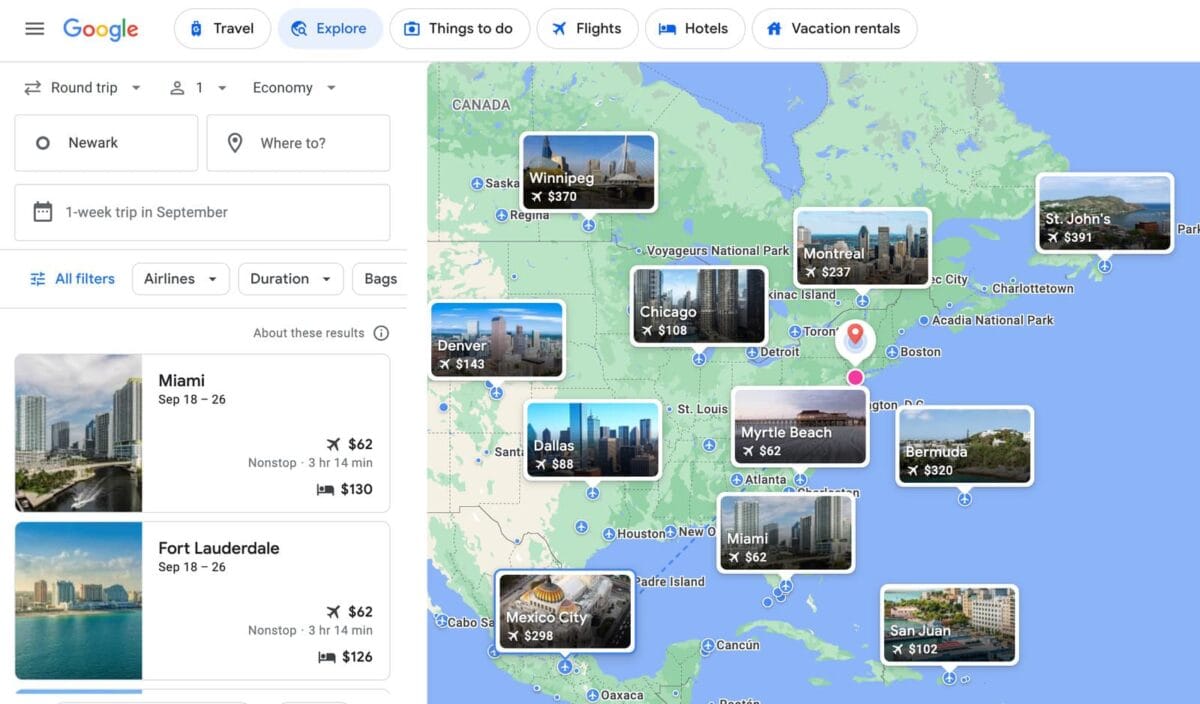
Using Google Flights Explore does come with some limitations that are worth highlighting. For starters, you can’t filter by specific airlines. Rather, you can only narrow your query by the three main airline alliances: Star Alliance, SkyTeam, and Oneworld.
Additionally, Google Flights map view only shows flights within the next six months, whereas other search methods within Google Flights can show flights nearly one year out.
One final caveat is that the resulting prices and destinations shown may not necessarily be the lowest-cost flights. Taking some time to navigate the map on your own, including zooming in on destinations of interest, can provide further information than what appears at first glance.
How to Book Multi-City Tickets on Google Flights
Google Flights gives the option to search for one-way, round-trip, and multi-city flights. Opting for a multi-city ticket can save money and add convenience if planning a trip with multiple legs.

Once the multi-city search is selected, simply plug in the departure and arrival airports, travel dates, and any desired filters for the separate flights. Below is an example search for multi-city tickets to Amsterdam and Brussels. European destinations are particularly well-suited for multi-city travel due to the ease of train, bus, and discount airline connections between cities.

The search results page organizes the flight options by price and lists flight details, including departure and arrival time, flight duration, number of stopovers, and the associated emissions. In this example, I selected the cheapest direct flight options for both legs of the multi-city trip.

If these flights were booked as a pair of separate tickets, the total trip cost would go up significantly. Rather than a base fare of $888 for a multi-city ticket, you’d end up paying $2,042 to purchase separate one way nonstop flights.


The multi-city ticket hack may be less feasible in certain destinations, including islands or remote areas where the cost and logistics of getting to nearby airports would cancel out any potential savings on the flight.
How to Select Dates on Google Flights to See the Cheapest Day to Fly
When your travel dates are flexible, you can use Google Flights to hone in on the cheapest dates to fly.
After entering your departure and arrival cities, Google Flights can provide a wealth of information on ticket prices, projecting out several months, to find the cheapest flight.
Selecting either the date grid and price graph icons will provide intuitive visual displays of flight costs on different dates (more on these tools in the sections below).

However, Google Flights goes a step deeper to show how the flight price for your selected dates compares to historical trends.
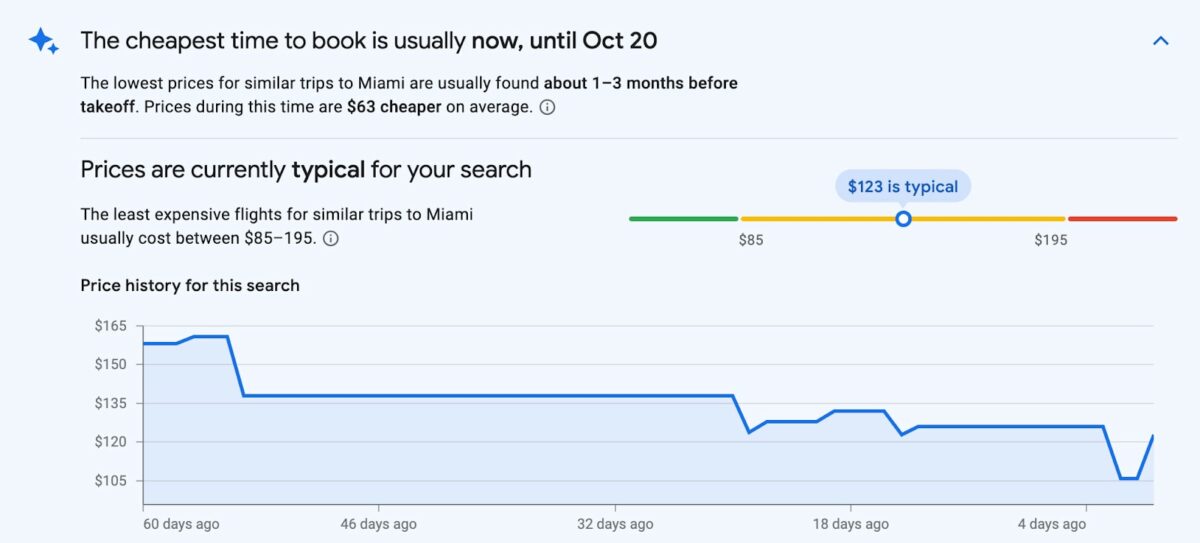
Using this “cheapest time to book” feature will illustrate how prices have fluctuated over the past 60 days and whether the price is low, typical, or high based on similar trips.
The tool also outlines how far in advance to book to find cheap flights for your selected route, as well as the total savings you can expect. For this example, the cheapest flights to Miami from New York are typically found 1-3 months before the departure date.
Using the Google Flights Date Grid
Clicking the Date grid icon on the search page will show the cheapest dates to fly for your selected route. The departure dates are listed across the top the the grid while the return flight dates run down the far-right column of the date grid.
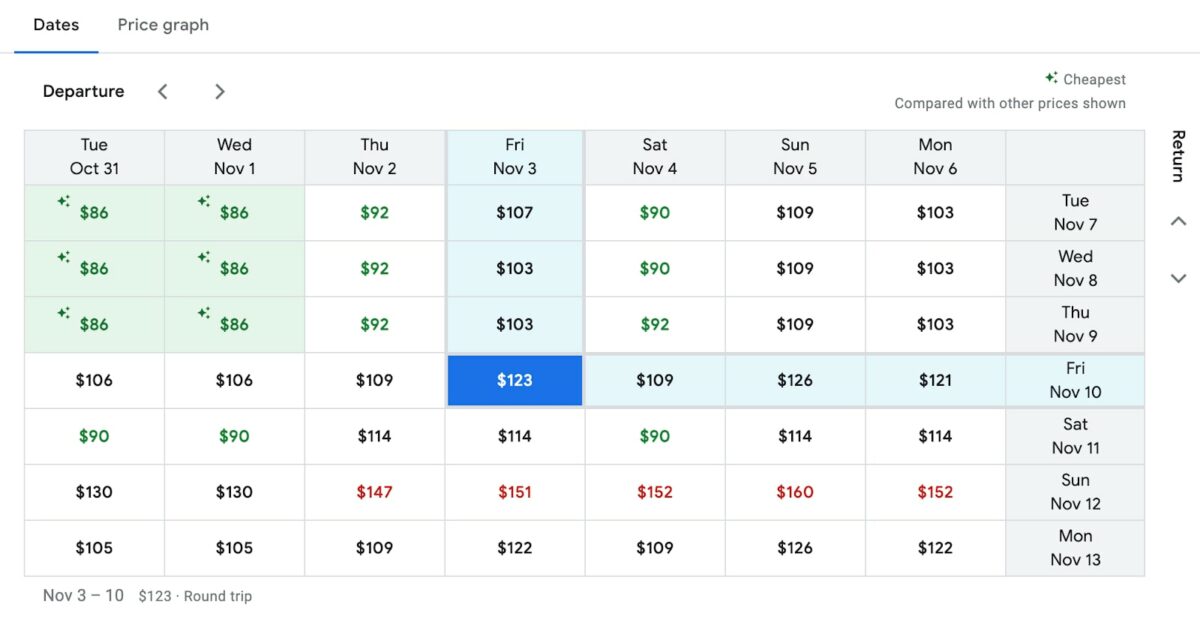
The date grid shows price comparisons for different departing flights and return flights over a one-week timeframe. If there are cheaper flights than the original selection, the better flight deals will appear in green while the cheapest dates will be highlighted in green. On the other hand, the most expensive flight dates are shown in red.
The default setting is to show the three days before and after your selected departure and return dates. To explore prices beyond the one-week range, simply click the arrows beside departure or return to broaden your flight search results.
Note that changing the departure dates won’t move the return dates, and vice versa.
Using the Google Flights Price Graph
Similar to the date grid, the Google Flights price graph tool helps compare prices and find the best flights. Whereas the date grid only shows a one-week window for prices, the price graph covers two months of flight fares in one place.
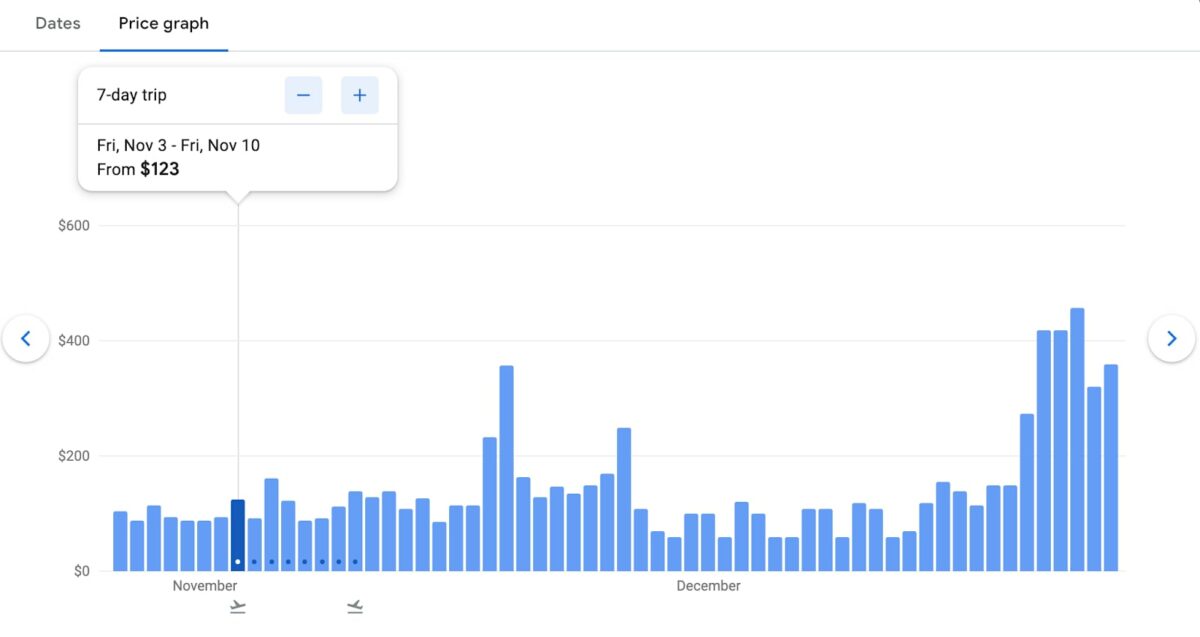
When you open the price graph, your selected departure date is automatically highlighted. Plane icons below the bar chart also identify your selected departure and return dates.
Hovering over any of the bars on the chart will show the fare price for flying that date for the same trip duration (7 days in this example). Hitting the – or + buttons will adjust the trip length while clicking the arrows on either side of the price graph will show ticket costs for earlier or future dates.
How to Filter Results in Google Flights to Find Your Perfect Flight
Finding the best flight can often involve more than just the price or specific dates. Google Flights has a multitude of ways to filter your flight search based on your needs and preferences.
Here’s an in-depth look at how each filter works with Google Flight search.
Number of Stops
Avoiding layovers on your trip can get you from A to B faster and reduce the risk of delays. You can use Google Flights to find nonstop flights or limit the number of layovers in your search results.
More specifically, the filter gives the option of selecting nonstop only, 1 stop or fewer, 2 stops or fewer, or any number of stops. Like all the filters, it’s located below the search bar containing the place of departure, destination, and flight dates.
Once you hit search, all the flights that appear will be limited to those that correlate with the number of stops filter.
Note that non-stop flights are usually the most expensive. If you book flights with a stop, it’s recommended to have at least a one-hour layover time for domestic flights and two hours for international flights.
Airlines
Are you a member of a frequent flyer program? If so, you can filter for a specific airline or airline alliance. For instance, frequent travelers working towards Platinum in the SkyMiles program may want to narrow their search to just Delta flights.
Instead of choosing just one airline, it’s also possible to weed out any unwanted airlines in your quest for the best flights.
Google Flights partners with over 300 airlines and online travel agencies to source its search results. A notable exception is Southwest. Though Southwest flights can appear in the search results, the fare prices aren’t disclosed on Google Flights.
Bags
If you need to check luggage, Google Flights can factor that into your search. By adding one checked bag as a filter, you’ll only receive flights that include checked luggage in the fare.
The bags filter also gives the option to search for flights that include carry-on luggage. Basic economy fares or budget airlines that have fees for a carry-on bag would be filtered out in this scenario.
Note that there’s no option to filter for two or more checked bags, as this is usually charged as a separate fee by the airline.
Price Ceiling
To find flights in your budget or focus on the cheapest flight deals, you can set a maximum price point that you’re willing to pay to pare down the flight choices.
The price ceiling filter functions as a sliding scale with variable price increments depending on the flight search. To adjust, simply drag the dot to the left to lower the price or the right to increase the range of options.
Flight Times
Not a morning person? Or want to avoid a red-eye flight? Google Flights gives you the power to filter results according to departure and arrival times to find the best departing flights.
If you want to book flights roundtrip, you can set time ranges for both the outbound and return flights.
Emissions
Air travel produces CO2 and other greenhouse gas emissions that contribute to climate change. Google Flights calculates the CO2 emissions, measured in kilograms, for each flight.
Sustainable-minded travelers can set a filter to only see flights with less emissions. Google Flights defines less emissions as flights with lower than typical emissions for that route.
The results will disclose the emissions for each flight to the left of the price. The figure represents the estimated emissions for 1 passenger in the selected seating class. Flying first class or business class, for instance, would translate to more emissions than an economy ticket on the same flight.
Connecting Airports
Not all airports are created equal in terms of amenities like dining and lounges. With the connecting airports filter, Google Flights lets you select or filter out where you’ll have your layover.
Layover Duration
In addition to handpicking your stopover airport, you can set a threshold for the layover duration as part of the connecting airports filter. Setting a filter for the layover duration can help identify faster routes, as well as reduce the risk of a missed connection.
Flight Duration
Google Flights lets you filter by the length of time you’ll spend on the plane. You can adjust the flight duration by one-hour increments to refine the results.
However, leaving this filter unchecked could help snag a flight deal. The cheapest flights usually entail more frequent stops and longer flight durations.
Other Flight Data on Google Flights
There’s other flight information that travelers might want to consider when comparing flights that aren’t covered by the Google Flights filters.
Want to know if a flight has free Wi-Fi or in-flight entertainment? Or maybe you’re concerned about legroom with an economy ticket?
Clicking on flights in the search results can often reveal these important details, plus others, such as the availability of an in-seat USB outlet. In the case of legroom, Google Flights will even let you know how it compares to the average, as demonstrated below.
While these details may not always be make-or-break factors, they’re helpful in setting expectations for a flight so you can plan accordingly.
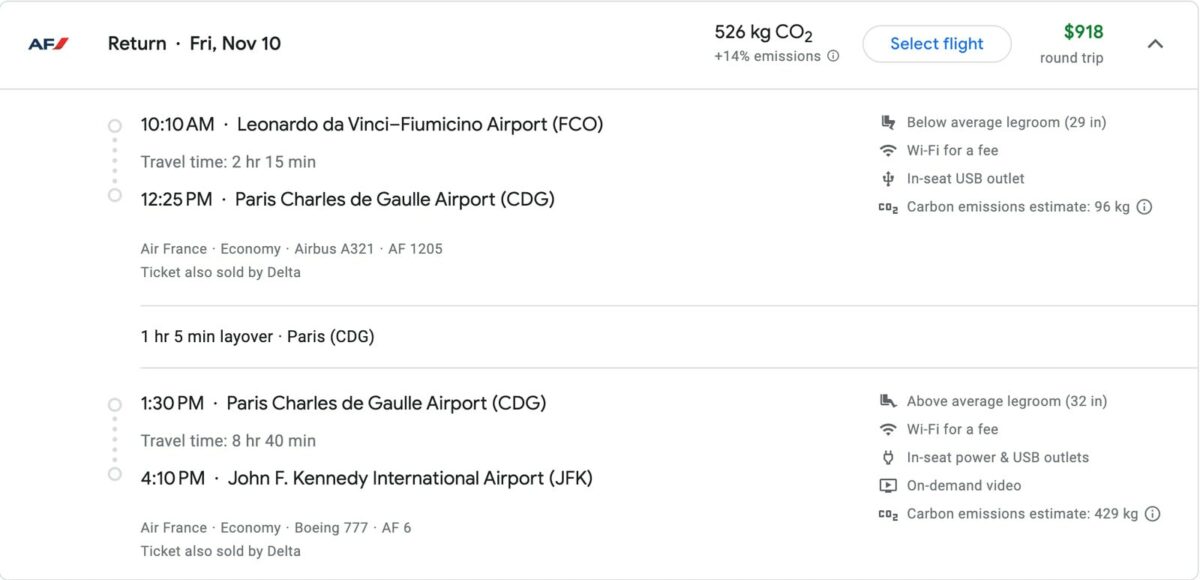
How to Track Flight Prices on Google Flights
Whether you need to firm up your travel plans before booking or want to hold out for a flight deal, Google Flights price tracking has you covered.
After entering your flight information on the search page, click the “track prices” toggle to get email notifications if and when the fare goes up or down in price. You’ll need a Gmail account to receive a cheap flight alert for your selected route.
If your travel plans are flexible, you can select “any dates” for price tracking instead of specific dates.

The flight alerts will account for any other filters you set, such as only JetBlue flights departing after 9 a.m.
Travelers can set multiple flight alerts to track prices for any number of trips. Besides the email notifications, you can review your price tracking efforts from the Google Travel dashboard which is accessible from the left-hand navigation.
Setting alerts to track prices could help get you money back on a flight if the price drops after you’ve booked. Google Flights has a Price guarantee pilot program that can pay the difference on eligible round-trip and one-way flights in the United States.
The price different must be more than $5 USD to qualify. Payments are limited to $500 USD per calendar year for up to 3 open Price guaranteed bookings.
Booking Flights Directly with Airlines
So after diligently setting alerts and tracking prices, you’re finally ready to book. Unlike an online travel agency, Google Flights lets you finish your booking through an airline website.
Once you’ve selected your flights, Google Flights will list one or more booking options to click on and finalize the flight reservation. Options may include online travel agencies in addition to the airline website. Be sure to check if the booking option is eligible for Google Flight’s Price guarantee before proceeding.
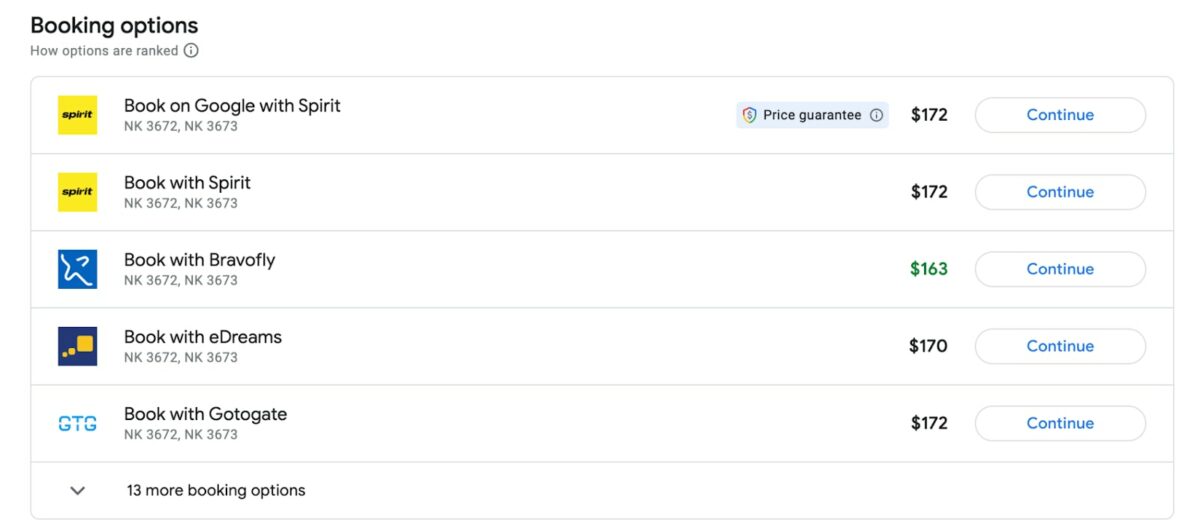
Remember: Google Flights Doesn’t Work with Southwest Airlines
There’s a lot to unpack when explaining how to use Google Flights. One caveat to keep in mind is that flights with Southwest aren’t featured on Google Flights.
The budget airline doesn’t work with external travel sites when it comes to booking flights. If you want to be certain that you’re getting the cheapest flight, it’s worth doing a quick search on Southwest’s website to compare airfare.
How to Change Your Currency and Language on Google Flights
If you’re traveling abroad and using Google Flights, the site may show up with a foreign currency or language as the default setting. Or maybe you’re hoping to sniff out deals on flights by using a foreign currency.
In either case, there are two ways to change the currency and language on Google Flights. Scroll down to the bottom of the page and find three icons showing (from left to right) language, location, and currency.

Alternatively, you can click on the hamburger menu in the top left of the page, which will open up the left-hand navigation with “Change language” and “Change currency” listed just below “Tracked Flight Prices”.
Pro Tips for Using Google Flights
Google Flights has a wealth of filters and functionality to help travelers hone in on the flight that best fits their itinerary, budget, and travel style. Finding the best deal often takes a combination of tactics, but here’s a quick roundup of tips to optimize your Google Flights search.
Search Across Multiple Airports
Many destinations, especially highly-populated metro areas like London and Rome, are near multiple airports. Expanding your search to cover neighboring airports could reveal significant price discrepancies that may be worth flying to the second, third, or even fourth closest airport to your final destination.
Google Flights lets you enter up to seven departure and destination airports. And when you hit search, the cheapest options will be displayed at the top of the results.
View Prices Across the Date Grid, Calendar, and Price Graph
If you have a specific destination in mind, Google Flights has a number of tools to hone in on the best price. We recommend examining price comparisons across the date grid, calendar, and price graph views to help identify which dates offer the best price point. Each offers a slightly different view which could reveal different prices.
Set Price Alerts
If you’re looking for flights far in advance or want to hold out for cheaper airfare, setting price alerts can help ensure you don’t miss a price drop. It’s also a way to essentially “save your work” after spending considerable time experimenting with different filters and exploring prices across multiple destinations and airports.
And if you change your mind on a trip or end up booking a flight, removing routes or canceling email notifications can be accomplished with just a few clicks.
Do a Final Price Check With The “Cheapest Time to Book” Feature
Before paying for your flight, it’s worth taking a quick glance at Google Flights’ “cheapest time to book” feature. This handy tool shows how the price on your selected flight stacks up to the typical fare for the route.
Again, Google Flights will show on a line chart where the price falls, and whether it’s cheaper, typical, or higher than the norm. It’s an easy final step and give peace of mind that you did your due diligence.
Google Flights Alternatives
There are many advantages to using Google Flights to find cheap airfare, unearth the cheapest airport to fly to, or snag deals on business-class tickets. But how does it compare to using an online travel agency or other flight search engine?
Here’s a quick look at other sites that specialize in finding cheap flights and flight deals.
Skyscanner
Skyscanner is a flight search engine that’s known for finding cheap flights and casting a wide net when searching for flight deals and prices.
Like Google Flights, Skyscanner lets you do flexible date searches and browse for the cheapest fares from multiple airports at the same time. Both websites can track prices on flights and send alerts on price changes. Skyscanner also offers multi-city bookings, letting users search multiple departure points for up to six legs of a multi-stop journey.
One notable difference is that Skyscanner lets you browse for flights at the country level rather than specific cities or airports. Skyscanner also searches a wider array of smaller travel sites, which can unearth deals that Google Flights might miss. On the other hand, Google Flights has the advantage of providing more detailed price information through its cheap time-to-book feature.
Hopper
Hopper is another search engine for booking airfare, as well as hotels and rental cars. The online travel agency facilitates bookings up to 1 year in advance and claims to deliver 95% accuracy in its search results.
To get Hopper’s full functionality, you’ll need to download the mobile app and create an account if you plan to book through the platform. With each search, Hopper offers price predictions to inform whether travelers should book now or wait for a better deal. This handy feature delivers comparable insights to Google Flights’ cheapest time to book tool.
A notable difference between the two search engines is that Google Flights sources real-time data while Hopper bases its price recommendations on historical trends.
Though both Google Flights and Hopper offer a price-back guarantee, Hopper only monitors price changes for 10 days after booking. Another key distinction is that Google Flight provides compensation via Google Pay while Hopper’s price-back guarantee issues “Carrot Cash”, which is a form of credit that can only be used within the app.
Momondo
Momondo is another popular search engine for finding cheap airfare, plus hotels, rental cars, and bus and train tickets. The platform was founded in Denmark in 2006 before being sold to Booking Holdings, which also owns and operates Kayak, Trivago, and other travel companies.
Like Google Flights, Momondo directs users to online travel agency or airline websites to complete their flight booking. Both sites make it easy to search for multi-city flights, too.
Momondo offers a solid range of filters, including the option to sort results by cabin type: basic economy, economy, premium economy, business class, or mixed. Note that filters can only be applied after you hit search, whereas Google Flights lets users add or adjust filters at any time.
In a head-to-head comparison, Momondo has some disadvantages as a flight search engine. For one, the site isn’t as effective at sourcing and displaying prices across weeks or months to identify the cheapest time to fly. Momondo is also more limited in its ability to do an open-ended search of cheap places to fly from a given city or airport.
Kiwi
When it comes to finding the cheapest itinerary, Kiwi is a solid choice. That is assuming you don’t mind a combination of trip legs, potentially involving planes, trains, and automobiles to get the best deal.
Kiwi is on par with Google Flights in terms of its intuitive search interface, flight alerts, and open-ended searches. What sets Kiwi apart is how it integrates several travel hacks—self-transfer, throwaway ticketing, and hidden cities—into its search engine.
Self-transfer allows travelers to search itineraries that airlines may not offer by combining separate flights from different airlines. Throwaway ticketing lets you book one-way tickets for the same cost of round-trip tickets if the latter is cheaper.
Hidden cities ticketing involves booking a multi-stop itinerary that’s cheaper than a direct flight to your desired destination. But rather than completing the full journey, you exit after the first leg.
Using these travel hacks can create complications if a flight is delayed or canceled. They may also go against the terms and conditions that airlines set. And in the case of hidden cities, checking baggage isn’t an option since it’ll continue on to the last destination on the ticket.
When searching flights, Kiwi also gives the option to look for one-way, roundtrip, and multi-city tickets. However, it’s through Kiwi’s Nomad feature that travelers can best optimize their multi-city flight searches. After selecting Nomad, add the destinations and the desired length of stay (e.g., 3-5 days) to have Kiwi calculate the cheapest route for your multi-stop itinerary.
Why Trust TravelFreak?
Here at TravelFreak, we want to equip fellow travelers with the best information to get out and explore the world. We’re committed to providing every piece of knowledge we can to help handle your next adventure like a pro.
Our brand reputation is based on giving high-quality recommendations and travel expertise you can trust, so we take our guides, reviews, and product selection very seriously.
The TravelFreak team is made up of lifelong travelers who’ve tried and tested a myriad of ways to stretch a travel budget, including saving on airfare. We’ve done our homework on the best travel sites and tricks so you don’t have to.
Kevin Brouillard wrote this comprehensive guide on how to use Google Flights based on thorough research and first-hand experience using the site and other flight search engines to land travel deals. He’s spent countless hours seeking out budget flights and travel deals around Europe, Southeast Asia, and North America.
The Bottom Line with Google Flights
Google Flights is an incredibly useful search engine for comparing airfare and finding deals. It’s packed with filters to narrow search results depending on your needs and preferences.
Google Flights is also a great tool for travelers looking to uncover the cheapest places to fly and the optimal time for booking tickets. It even gets into the nitty-gritty on legroom, carbon emissions, and live entertainment available on a given flight.
Compared to other flight search engines, Google Flights stands out for its price back guarantee and ability to simultaneously search flight routes between multiple airports. If your travel plans are flexible, other sites like Skyscanner or Kiwi could discover cheaper fares—but often with more complex itineraries that may or may not be worth the extra effort.
Google Flights FAQs
-
How does Google Flights work?
Google Flights searches hundreds of airline websites and travel agencies to find the best deals.
-
Is it OK to book through Google Flights?
Google Flights doesn’t handle the booking of any flights. It only searches flight prices.
-
How do I use Google Flights without a destination?
To search anywhere with Google Flights, simply leave the destination field blank, and hit search.
-
Why are Google Flights cheaper?
Google Flights can find cheap flights because it sources from hundreds of airlines and travel sites.
-
Is anything cheaper than Google Flights?
Checking Google Flights alternatives like Skyscanner and Kiwi can uncover low-cost airfare.
